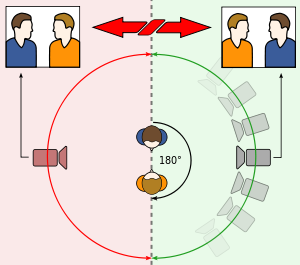Temporal Continuity
Temporal continuity is when film makers make sure people/things move around over time. An example of temporal continuity is if their is a scene where two characters are having a dialogue, everytime the camera cuts to the smoker the director has to be sure that they make that the cigarette is the same size or just a bit shorted. If the cigarette is unconsistent and continually gets longer and shorter, this is called Discontinuity.
Spatial Continuity
Spatial continuity is when film makers make sure that nothing is moved within the space of narration. An example of this is in the movie Fargo. When the two characters are in the bar speaking to one another, due to the cuts, you can clearly see the glasses moving places. This is called spatial discontinuity as it isn't a smooth transition from one scene to another. There are rules that directors within media have to follow, one of them being the 180 degree rule.

The 180 degree rule is when the camera can not enter the left hand side of the person (from facing behind the actor) without showing the transition in a scene. This is because it would confuse the audience and disorient them. An example of this is the british TV presenters Ant and Dec, with Ant always standing on the left, and Dec always standing on the right. The director makes an invisible axis with a left/right character ratio at all times. If a car enters from the left side of the screen, it is important that it stays in the middle, or the left hand side of the screen.
A film technique wherein one character is shown looking (often off-screen) at another character, and then the other character is shown looking "back" at the first character. Since the characters are shown facing in opposite directions, the viewer unconciously assumes that they are looking at each other.
-Bordwell, David; Thompson, Kristin (2006). Film Art: An Introduction. New York: McGraw-Hill.
The shot/reverse shot focuses on the eye level from one character to another when off screen as the audience assumes they are looking at each other. Among other things, it also focuses on the 180 degree rule as it doesn't decieve the audience then.
The match on action within a film is a cut in film editing either between two objects, two different spaces, or two different compositions. This is to make the transition between cuts smooth often helping to make a strong continuity by linking two shots simultaniously.
I think continuity is very important when it comes to editing as it adds realism to a film. If you can notice the difference in every cut, films wouldnt be so popular, just like in the early 1900's.
Bibliography - Image supplied by http://www.wikipedia.org/
http://www.artoftheguillotine.com/index.php?page=shotreverseshot
Filmography - Fargo
Year - 1996
Director - Joel Coen
http://www.imdb.com/title/tt0116282/

Targets:
ReplyDeleteGraph Analysis
Homework
Images and Video embedded for support